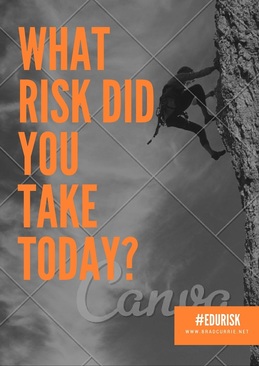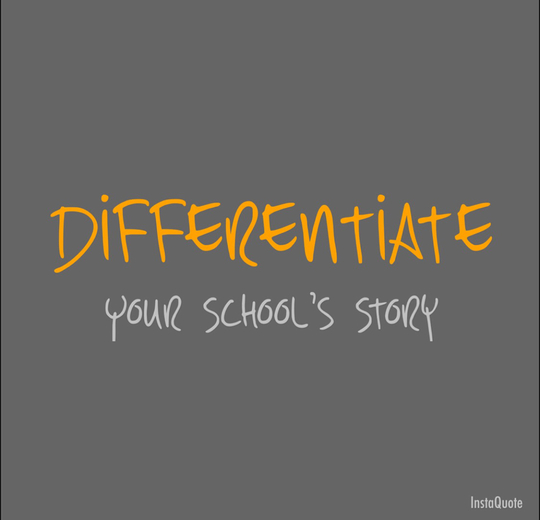|
Taking risks means different things to different people. Sometimes they work out and sometimes they don't. This sort of culture only exists where support structures are in place and autonomy is front and center. Every day we should be asking ourselves this very important question: What risk did I take today? An #EduRisk could be something as simple as utilizing Google Docs in class so that students can collaborate on a project. Or changing the seating arrangements from rows to pods to promote more discussion. School and district leaders can take a risk by letting their staff and students know that failure is perfectly acceptable and that risk-taking is encouraged. The bottom line is that they only way we grow is by starting somewhere and then move forward. One of the hardest things to do is putting yourself out there and trying something new. It's incredibly uncomfortable and could potentially open you up to criticism. You know what? That's perfectly fine. Because at the end of the day you deserve better and more importantly our students deserve better. Here are eight examples of #EduRisks worth taking to promote the success of students and grow as an educator...
The time is now to take an #EduRisk and create learning experiences that are memorable and meaningful. It's a team effort and will pay off in the long run. The whole point is to create an environment that students will remember for a lifetime and twenty years down the road can look back and speak fondly of their time in school. Brad Currie is the author of All Hands on Deck: Tools for Connecting Educators, Parents, and Communities and the newly released Personalized PD: Flipping Your Professional Development. He is one of the founding partners of Evolving Educators LLC. Brad is a 2014 ASCD Emerging Leader and Google Certified Trainer. Brad currently serves as a K-8 Supervisor of Instruction and Dean of Students for the Chester School District in Chester, NJ. He is a Google Certified Trainer and speaks nationally about tech integration. Learn more about Brad by following him on Twitter @bradmcurrie or visiting his website at www.bradcurrie.net.
0 Comments
The time is now to rethink the way classrooms, schools, districts, and organizations communicate with stakeholders in the digital world. Differentiation is key if students, parents, and community members are to stay informed and feel proud of daily accomplishments that take place in their educational institutions. I speak to this in my book All Hands on Deck: Tools for Connecting Educators, Parents, and Communities. I truly believe that if you do not tell your story someone else will and it could be wrong. In my upcoming book, 140 Twitter Tips for Educators, the importance of connecting with school stakeholders through tweets is highlighted in great detail and stresses the importance of accessing real time information from a few taps of a person's mobile device. Here are five ways communicate with stakeholders in the digital world... Smore: Create weekly or monthly digital newsletters to keep stakeholders informed of school and district happenings. Canva: Design visuals and engaging documents that can be shared out and downloaded by stakeholders across multiple platforms. Tumblr: Host a classroom, school, or district blog that highlights all the wonderful educational experiences that place on a daily basis. Periscope: Create an online television channel that stakeholders can then access in real time to stay current in a more authentic and personal manner. Tip: use Katch to archive Periscope episodes. Snapchat: Reach your student population to inform them of upcoming events and celebrate accomplishments. It's important that educational institutions meet their stakeholders where they are in the digital world. No better way to do this than by leveraging the power of available web tools and social media. Take a risk and choose a few of the tools mentioned above. It's perfectly fine if it doesn't work out. The important thing is that you begun the process of exploring what is possible. Over time, it will become more clear which tools meet your stakeholders' informational needs. Brad Currie is the author of All Hands on Deck: Tools for Connecting Educators, Parents, and Communities and the newly released Personalized PD: Flipping Your Professional Development. He is one of the founding partners of Evolving Educators LLC. Brad is a 2014 ASCD Emerging Leader and Google Certified Trainer. Brad currently serves as a K-8 Supervisor of Instruction and Dean of Students for the Chester School District in Chester, NJ. He is a Google Certified Trainer and speaks nationally about tech integration. Learn more about Brad by following him on Twitter @bradmcurrie or visiting his website at www.bradcurrie.net.
In the near future, probably April, my new book will come out. It's titled 140 Twitter Tips for Educators and is being published by Burgess Consulting. I am writing the book with my fellow Evolving Educator partners Billy Krakower and Scott Rocco. As I was writing my portions of the book I jotted down some things that Twitter should be able to do, but currently does not for one reason or the other. 1. Modify sent Tweets. Facebook allows users to modify posts. Why can't this become reality in the Twitter world? 2. Pre schedule tweets. There are great apps like Buffer, Hootsuite, and Tweetdeck that allow users to pre schedule tweets. So why can't Twitter have this same feature? 3. Tweet more than 140 characters. I heard that this feature may soon become reality. Sometimes a tweet just needs a few more characters. 4. Have share options embedded. It would be cool if users were able to share to other social media sites right from a tweet. 5. Earn credit icon. Since many Twitter users are educators they should be able to earn professional development credits while sharing and interacting through tweets. It would be nice if there was some way to archive Twitter work by tapping a little icon. 6. Archive option for chats/hashtags. Twitter users love to participate in chats. Many of the archiving options are clumsy or too difficult at best. There is one tool out there that has potential and it's made by Participate Learn. l wish there was an Archive Chat option feature within Twitter that would save an hour long discussion thread from a particular hashtag. 7. Access to data from past polls. I love the new poll feature that Twitter now offers. Access to the data associated to the polls is limited. Or at least that is how I understand it. There should be a feature within the poll function that archives past polls. Maybe I am way off base with this blog post. Do you have any suggestions to enhance Twitter? If so, share them in the comments portions of this blog post. |
Archives
May 2020
Categories
All
|


 RSS Feed
RSS Feed
